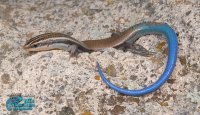| Range: |
 |
| Other Names: |
|
| Description: |
A small (up to 76 mm or 3" from snout to vent), shiny lizard with a thick neck, a small head, and small limbs. Coloration is copper, olive, or golden brown and the tail is bright blue. A wide, dark brown stripe runs along each side of the body extending from the eye to the hind limbs. This stripe is often bordered on its upper edge by a thin pale stripe. Many specimens, particularly juveniles and young adults, have pale lines that form a Y shape on top of the head. Adult males occasionally develop a reddish tint on the lips. The scales are large, rounded, smooth, and very shiny. This is the only skink in New Mexico that retains its blue tail coloration into adulthood. |
| Similar Species: |
The Great Plains Skink is larger, lacks distinct stripes,is black as a juvenile or light yellowish-brown to tan as an adult and has lateral scale rows that are oblique to the dorsal scale rows. The Many Lined Skink either lacks stripes altogether or has a light middorsal band and four light longitudinal stripes, with the dorsolateral pair confined to the 3rd scale row from the middline, lacks a Y-shaped mark on the head and has a divided post-mental scale. |
| Venom: |
None |
| Habitat: |
In New Mexico the Mountain Skink inhabits Madrean Evergreen Woodland and the upper reaches of adjoining Semidesert Grassland communities. It is most often found under rocks, logs, and other surface cover in moist areas such as riparian corridors, rocky canyon bottoms, and grassy hillsides. |
| Behavior: |
Active during the day but most activity occurs under surface cover. When spotted it can be quite difficult to capture as it quickly slides and zigzags through the grass, rocks, and surface cover. It is capable of casting off (and regenerating) the tail. Pursuers and predators often end up with nothing but a wiggling tail. |
| Hibernation: |
|
| Reproduction: |
This skink lays a clutch of up to 6 eggs in spring or early summer. The female remains in the nest with the eggs to guard them. Live birth has also been documented in this species in Arizona. |
| Diet: |
The Mountain Skink feeds on beetles, flies, and a variety of other insects. It also eats a variety of spiders. |
Adapted from account on reptilesofaz.org
Sources:

|







